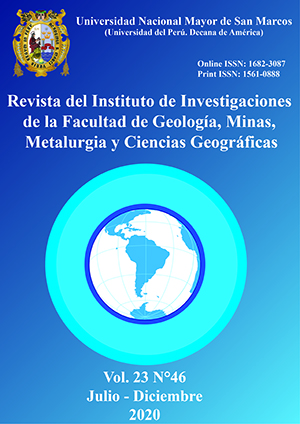Mega structural system Cajamarca, structural construction suggested in relation to the mineralization of porphyries and epithermals in northern Peru
DOI:
https://doi.org/10.15381/iigeo.v23i46.19187Keywords:
Mega structural systems, dextral, sinestral, deposits, inca and quechua phasesAbstract
The north of Peru is characterized by the presence of world-class porphyry (Cu-Au and Cu-Mo) and epithermal (Au) deposits, located on the west of central Andes, northern Peru. These mines and mineralized deposits are present in a temporal-structural associated with Neogene magmatism with ages from 24 Ma to 7 Ma, intruding silica-clastic rocks from the upper Cretaceous, which, due to the effects of tectonic deformations, particularly in the Cenozoic (Incaica and Quechua phases), led to the occurrence of mega controls Structural problems such as the one proposed in the following publication and hopes to open a window of debate in its environment. Structurally, the deposits in the north of Peru are controlled by mega structural systems that contain the Punre - Canchis fault (Rivera et al., 2008) in the eastern sector as the main structural accident, as well as the system of folds and faults of the Marañón, and in the Western sector include faults to the East of Chongoyape that limit the eastern edge of the Batolito of the Coast, as well as the silicoclastics of the Mesozoic, putting them in contact with volcanos of the Cenozoic. The basin in its western sector would have undergone changes in the status of regional efforts, producing epirogenic movements, since the Upper Cretaceous, with large regional faults playing an important role, controlling the extensive basin through normal faults. (Pardo-Casas & Molnar, 1987). The subduction occurred obliquely and with a low angle, thus generating permeable zones, of kilometer dimensions generating mega parallel and conjugate structures that gave rise to structural jogs. The analysis and evaluation of the compiled information allows us to suggest a new concept to define the structural behavior of this sector in the Peruvian Andes, proposing a new denomination Mega Cajamarca Structural System for a sinextral system with compressive behavior and with Andean direction in the Miocene. It is also considered that in this north sector, an oblique convergence plaque area has been developed in the subduction zone, as well as the subduction angle variation (15 degrees), as main characteristic for the mineral deposit generation. In this way, this concept has the principal objective to involve a general mechanism of an ensemble understanding and interpretation, including previously developed structural studies.
Downloads
Published
Issue
Section
License
Copyright (c) 2020 Jesús A. Torres Guerra, José Tumi Pacheco, Mariel Samanez Trigoso, Yordy Caycho Vilca

This work is licensed under a Creative Commons Attribution-NonCommercial-ShareAlike 4.0 International License.
AUTHORS RETAIN THEIR RIGHTS:
a. Authors retain their trade mark rights and patent, and also on any process or procedure described in the article.
b. Authors retain their right to share, copy, distribute, perform and publicly communicate their article (eg, to place their article in an institutional repository or publish it in a book), with an acknowledgment of its initial publication in the Rev. Inst. investig. Fac. minas metal cienc. geogr.
c. Authors retain theirs right to make a subsequent publication of their work, to use the article or any part thereof (eg a compilation of his papers, lecture notes, thesis, or a book), always indicating the source of publication (the originator of the work, journal, volume, number and date).






